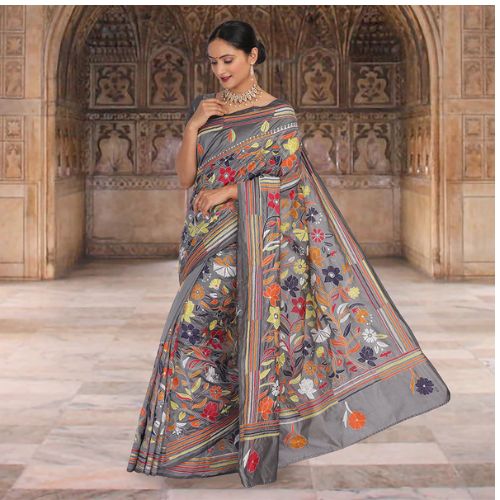The sari, an exquisite and elegant traditional Indian dress, is not merely a garment but a representation of rich cultural heritage and artistry. Draping a sari is an art form in itself, with various regional styles and techniques that enhance the beauty and grace of the wearer. This timeless attire has captivated the hearts of women across generations, not only in India but also around the world. In this article, we will explore the art of draping a sari Indian dress, offering a step-by-step guide along with insights into different regional draping styles and essential tips to achieve the perfect look.
Understanding the Sari:
A sari is a long piece of fabric, usually ranging from five to nine yards in length, and around 1.2 meters wide. It is traditionally worn by women in India, Sri Lanka, Bangladesh, Nepal, and other South Asian countries. The fabric is draped around the body in various ways, with one end known as the “pallu” or “aanchal” falling gracefully over the shoulder.
Step-by-step Guide on How to Drape a Sari:
Step 1:
Choosing the Right Sari: Select a sari that resonates with your taste, the occasion, and your body type. Consider the fabric, color, and design to ensure it complements your personality and enhances your natural beauty.
Step 2:
Preparing the Petticoat: Start by wearing a well-fitted petticoat, a skirt-like garment that acts as the base for draping the sari. The petticoat should match the primary color of the sari and be long enough to allow the sari to fall at the desired length.
Step 3:
Tying the Knot: Take the plain end (non-pallu end) of the sari and tuck it into the petticoat slightly to the right of your navel. Wrap it around your waist once and ensure the lower border of the sari touches the floor.
Step 4:
Making Pleats: Hold the remaining fabric in front and start making pleats (5 to 7) of approximately 5 inches each, neatly folding them together. Tuck these pleats into the petticoat, slightly to the left of the navel, and ensure they are even and straight.
Step 5:
Draping the Pallu: Drape the pallu over your left shoulder from behind, allowing it to fall gracefully over your left arm. You can let the pallu hang loose or pin it to the shoulder for a more secure hold.
Step 6:
Final Adjustments: Smooth out any wrinkles, adjust the pleats, and ensure the sari is comfortably draped around your body. Take a moment to admire yourself in the mirror and make any necessary adjustments to achieve the desired look.
Different Regional Draping Styles:
a) Nivi Style (Andhra Pradesh):
The Nivi style is one of the most common and widely recognized sari draping styles in India. It involves pleating the sari and tucking it into the petticoat with the pallu draped over the left shoulder.
b) Bengali Style (West Bengal):
The Bengali style features wide pleats in the front, with the pallu wrapped around the waist and draped over the left shoulder. The unique aspect of this style is the pleats are worn on the outside.
c) Maharashtrian/Kashta Style (Maharashtra):
The Kashta style involves draping the sari between the legs, which forms a trouser-like appearance. The pallu is worn over the left shoulder and often features intricate designs.
d) Gujarati/Rajasthani Style:
This style involves pleating the sari in the front and taking the pallu to the back over the right shoulder. The pallu is then brought to the front over the right shoulder again, creating a distinctive double-pallu effect.
Tips for Achieving the Perfect Look:
a) Ensure the Indian sari dress is neither too tight nor too loose, as the right fit is essential for comfort and elegance.
b) Use safety pins discreetly to hold the pleats and pallu securely in place.
c) Choose the right undergarments: Wearing the appropriate undergarments can significantly impact the overall look of the sari. Opt for seamless or well-fitted undergarments that do not create visible lines or bulges, ensuring a smooth silhouette.
d) Balance the accessories: While accessorizing your sari, strike a balance between simplicity and opulence. If your sari is heavily embellished or has intricate designs, choose minimalistic jewelry to avoid overwhelming the look. Conversely, a plain sari can be beautifully accentuated with statement jewelry pieces.
e) Consider the blouse design: The blouse or choli that accompanies the sari plays a crucial role in enhancing the overall appearance. Choose a blouse design that complements your body shape and the sari’s style. Experiment with different necklines, sleeve lengths, and back designs to find the most flattering option.
f) Pay attention to footwear: The right footwear can make or break your sari look. Heels or wedges are generally a good choice as they add height and elongate your silhouette. However, ensure they are comfortable enough to be worn throughout the event.
g) Confidence is key: Regardless of the style, fabric, or regional draping technique you choose, wearing a sari with confidence is essential. Stand tall, carry yourself with grace, and embrace the elegance of the sari. When you feel comfortable and confident, your beauty and poise will shine through.
h) Practice makes perfect: Draping a sari can be a skill that improves with practice. Before wearing it for a special occasion, spend some time practicing different draping styles and perfecting your pleats. Familiarizing yourself with the process will make it easier and more enjoyable.
i) Seek expert advice: If you are new to wearing saris or exploring regional draping styles, don’t hesitate to seek advice from experienced wearers or attend draping workshops. Learning from those who have mastered the art can provide valuable insights and techniques.
j) Hair and makeup: Consider the overall look you want to achieve and coordinate your hairstyle and makeup accordingly. Traditional hairstyles like the bun or braid often complement the elegance of the sari, while makeup can be adjusted to suit the occasion and personal preferences.
In final words, draping a sari indian dress is a beautiful art that showcases the diversity and richness of Indian culture. By following these tips and paying attention to the intricate details, you can achieve the perfect look and embody the timeless grace and charm that the sari represents. Whether you are attending a wedding, a festive celebration, or simply embracing the beauty of Indian attire, mastering the art of draping a sari will make you stand out with sophistication and elegance. Embrace this iconic Indian dress with pride and allow it to envelop you in its cultural significance and timeless allure.





